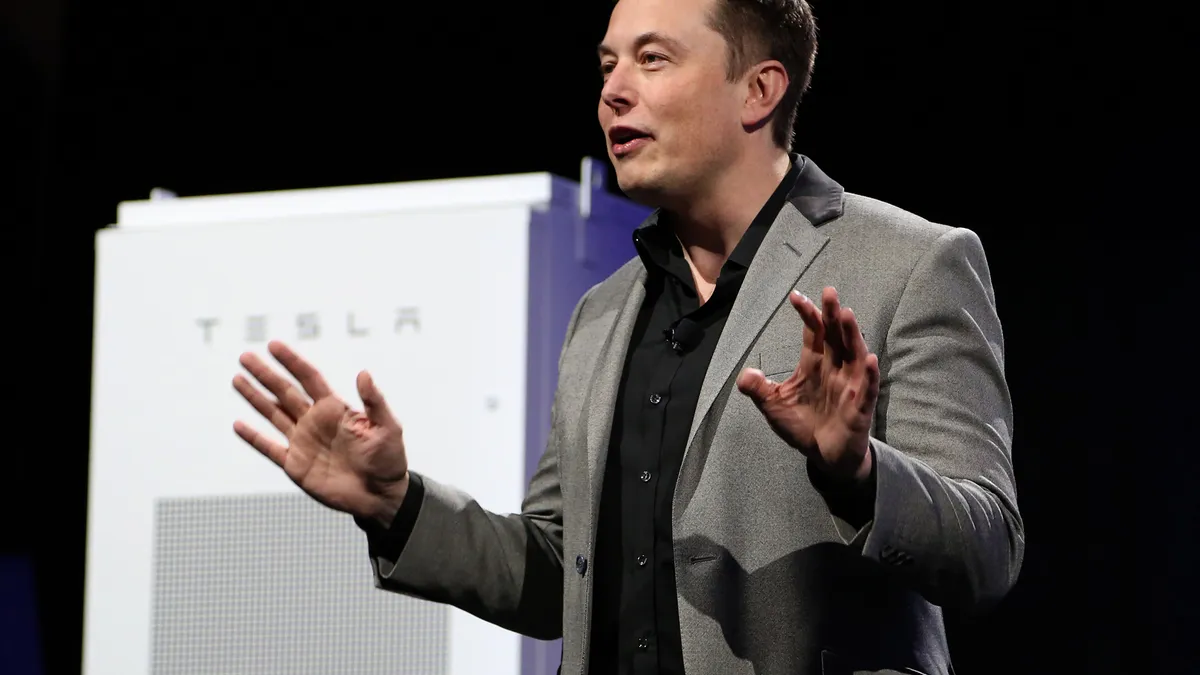Dive Brief:
- Tesla CEO Elon Musk revealed "part deux" of his master plan for the company in a Wednesday blog post, outlining a vision to expand Tesla's vehicle offerings and network them with rooftop solar and residential batteries.
- In addition to the Model 3 sedan, Musk wrote Tesla would soon offer a "future compact SUV and a new kind of pickup truck," as well as buses and semi trucks. Consumer vehicles, once autonomous, could be configured to provide ride-sharing services when not in use by the owner, earning income and reducing the overall cost of the car.
- The acquisition of Tesla's sister company SolarCity will allow Tesla to "create a smoothly integrated and beautiful solar-roof-with-battery product that just works," Musk wrote, "empowering the individual as their own utility."
Dive Insight:
Elon Musk often frames his business vision in terms of sustainability, as he did when announcing Tesla would buy SolarCity, the largest U.S. residential installer headed by his cousin Lyndon Rive.
“Our goal is to accelerate the advent of sustainable energy, so this is, broadly speaking, right in line with that,” Musk said at the time.
The second part of the Tesla Master Plan picks up on those themes, with Musk saying it is his way to help accelerate the day society stops using fossil fuels for electricity and transport.
In a post on the Tesla site, Musk said the company would offer an expanded vehicle product line and support the use of autonomous driving features for vehicle sharing. Through a smartphone app, a vehicle could be deployed to generate income for the owner.
"This dramatically lowers the true cost of ownership to the point where almost anyone could own a Tesla," Musk wrote. "Since most cars are only in use by their owner for 5% to 10% of the day, the fundamental economic utility of a true self-driving car is likely to be several times that of a car which is not."
In cities where demand for cars exceeds supply, Tesla will own and operate its own fleet, expanding the car and battery company into the ride hailing sector currently dominated by Uber and Lyft. Tesla is already vertically-integrated, owning nearly all aspects of its car and battery development.
Musk did not offer details of any potential partnerships with taxi services, but did indicate Tesla would also expand into mass transit and industrial transportation with new bus and semi truck offerings.
Those products may be smaller than is traditional, as the CEO wrote that it "probably makes sense" to shrink the size of buses as autonomous driving becomes more widespread, reducing traffic congestion. The role of a bus drive, Musk wrote, could become that of a fleet manager, overseeing numerous mid-sized vehicles that use algorithms to bring passengers all the way to their destination.
Beyond transportation, Musk said the combination of Tesla and SolarCity will allow the company to create a seamless residential rooftop solar-plus-storage system, cutting electricity costs for consumers, providing a sustainable charging source, and acting as a grid resource in aggregation.
Some analysts speculated that the Tesla merger was prompted by SolarCity's slumping stock price and struggles in regulatory battles over net metering, but Musk claimed the ability to offer an integrated solar-storage product through "ordering experience, one installation, one service contact, one phone app," was the motivation.
"That [the companies] are separate at all, despite similar origins and pursuit of the same overarching goal of sustainable energy, is largely an accident of history," Musk wrote. "Now that Tesla is ready to scale Powerwall and SolarCity is ready to provide highly differentiated solar, the time has come to bring them together."
This week,
Musk told the Wall Street Journal he expects shareholders to approve the Tesla-SolarCity merger by at least a two-thirds margin.
Tesla wants to pay $26.50 to $28.50 per share to buy SolarCity, a premium of up to 30% based on its June 21 stock price.
"In short," Musk wrote at the end of his post, "the master plan is:"
Create stunning solar roofs with seamlessly integrated battery storage
Expand the electric vehicle product line to address all major segments
Develop a self-driving capability that is 10X safer than manual via massive fleet learning
Enable your car to make money for you when you aren't using it.














